Temperature Sensors Market Size
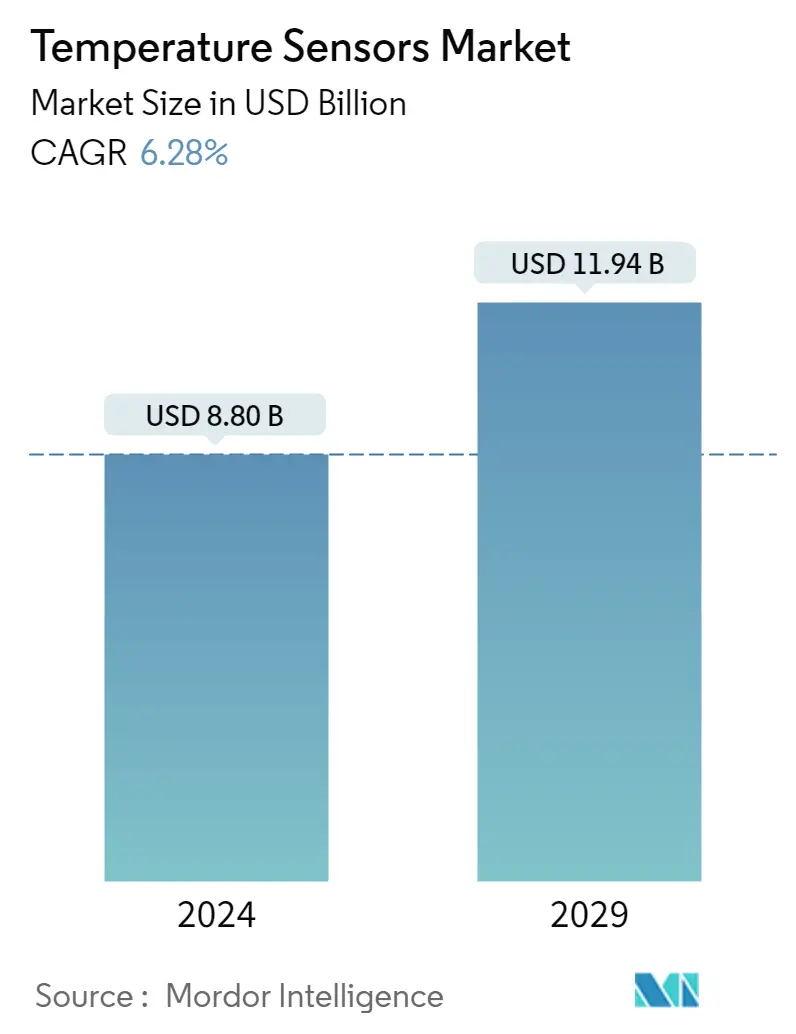
| Study Period | 2019 - 2029 |
| Market Size (2024) | USD 8.80 Billion |
| Market Size (2029) | USD 11.94 Billion |
| CAGR (2024 - 2029) | 6.28 % |
| Fastest Growing Market | Asia Pacific |
| Largest Market | North America |
Major Players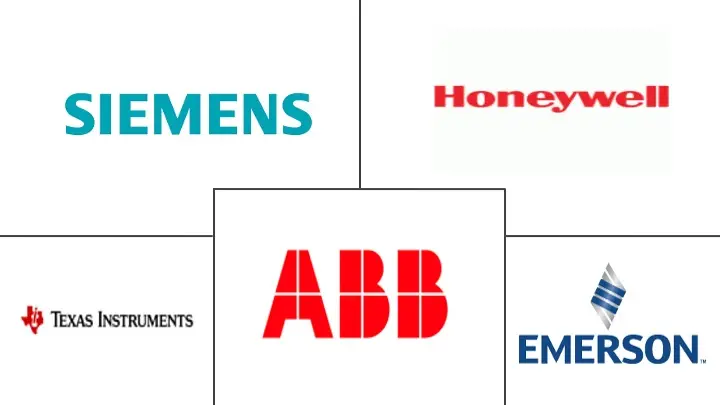
*Disclaimer: Major Players sorted in no particular order |
Need a report that reflects how COVID-19 has impacted this market and its growth?
Temperature Sensors Market Analysis
The Temperature Sensors Market size is estimated at USD 8.80 billion in 2024, and is expected to reach USD 11.94 billion by 2029, growing at a CAGR of 6.28% during the forecast period (2024-2029).
Temperature sensors employed using IoT connectivity are expected to speed up owing to the increasing need for COVID-19 testing and screening. Semtech and Polysense Technologies collaborated to develop temperature monitoring devices for a human body based on Semtech's LoRa LPWAN. The company's temperature sensors would offer frontline healthcare workers real-time data for faster screening of individuals with a high temperature.
- The growing adoption of HVAC modules in the automotive industry and industrial end users applications are some of the major driving factors of the temperature sensor market.
- Growing demand for consumer electronics is also expected to boost market growth further. An increase in the global focus on security and surveillance and various government initiatives toward safety norms is also expected to promote the adoption of the temperature sensor market.
- The growing adoption of wireless temperature sensors in various industries is mainly attributed to the applications of non-contact measurement features, which enable them to reach locations where a device's physical deployment is impossible.
- Various applications of temperature sensors, including flare systems, wellhead tanks, chemical tanks, pipeline data collection, and compressors, are among some of the multiple applications of temperature sensors in the oil and gas industry. The applications of temperature sensors in the oil and gas industry are considered critical. Installing a wired device inside a pipe or a tank would be inefficient if the operating temperature is relatively high.
- Further, the nature of the industry makes the usage of temperature sensors crucial, as it is essential to monitor the temperature changes in these lines and maintain safe working conditions. The super-heated steam and water pipelines are extended, and accidents in these may lead to the damage and loss of other assets, which is one of the driving factors for the demand and regulatory needs.
- Trends in the personal computing industry, such as smaller system sizes, faster processors, and the need to support more advanced applications, make monitoring and controlling heat imperative. This trend, coupled with robust sales and advancements in desktop and portable computers, is likely to continue to support the growth of temperature sensors.
- One of Honor's recently announced smartphones, the Honor Play 4 Pro, is available with an infrared temperature sensor. In the era of a COVID-19 pandemic, when a high temperature could be a sign of being ill with COVID-19, it could be a helpful smartphone feature. According to Honor, the sensor works between temperatures of -20 degrees Celsius and 100 degrees Celsius (approximately -4 to 212 degrees Fahrenheit), which is more than enough to cover the human body's range of potential temperatures, and it can sense temperatures down to the tenth of a degree.
Temperature Sensors Market Trends
This section covers the major market trends shaping the Temperature Sensors Market according to our research experts:
Infrared Temperature Sensors to Drive the Market Growth
- IR Temperature sensors, unlike many contact temperature sensors, could be used for taking readings from a moving object at less than 10 m/s. Such advantages of temperature sensors enable them to be used for multiple applications in various fields, including manufacturing, automotive, food processing, and defense.
- The applications of IR temperature sensors are also found in various defense applications, including variable emissivity measurements and optical target sighting, which helps track activities. All these applications have a continuous demand and advance owing to the increasing military spending.
- Recently, the demand for infrared temperature sensors has been increasing in the manufacturing sectors, driven by the global adoption of Industry 4.0 policies. IR temperature sensors, in the case of predictive maintenance, have been increasingly gaining a considerable market share. The increasing requirement for monitoring the temperature of moving parts could rarely be substituted with the efficiency of IR temperature sensors.
- In the case of the plastic molding industry, IR sensor technology can optimize thermoplastic demolding processes. In the automotive sector, IR temperature sensors are used in collaboration with paint workshops, which, with the help of intelligent algorithms, calculate the amount of time a chassis spends in the drying oven without affecting the paint job.
- The rapid surge in COVID-19 cases has caused nations worldwide to take steps to stop the spread. Ever since the deadly disease outbreak, there has been a need to check temperatures routinely. Large-area detection and screening for fever would soon be a reality for the safety of all and containment of not only the current COVID-19 impacting today but also a prescriptive measure of preparedness.
- An infrared body temperature monitoring system for large-area monitoring and detection would significantly improve awareness and control the spread of an outbreak. Such a system would have an effective alarm using a temperature range feature, the ability to track and raise alarms at multiple points, miss no targets, identify between human/animal/organic targets and other high-temperature objects and use video/photographic images for monitoring and analysis - all in real-time.
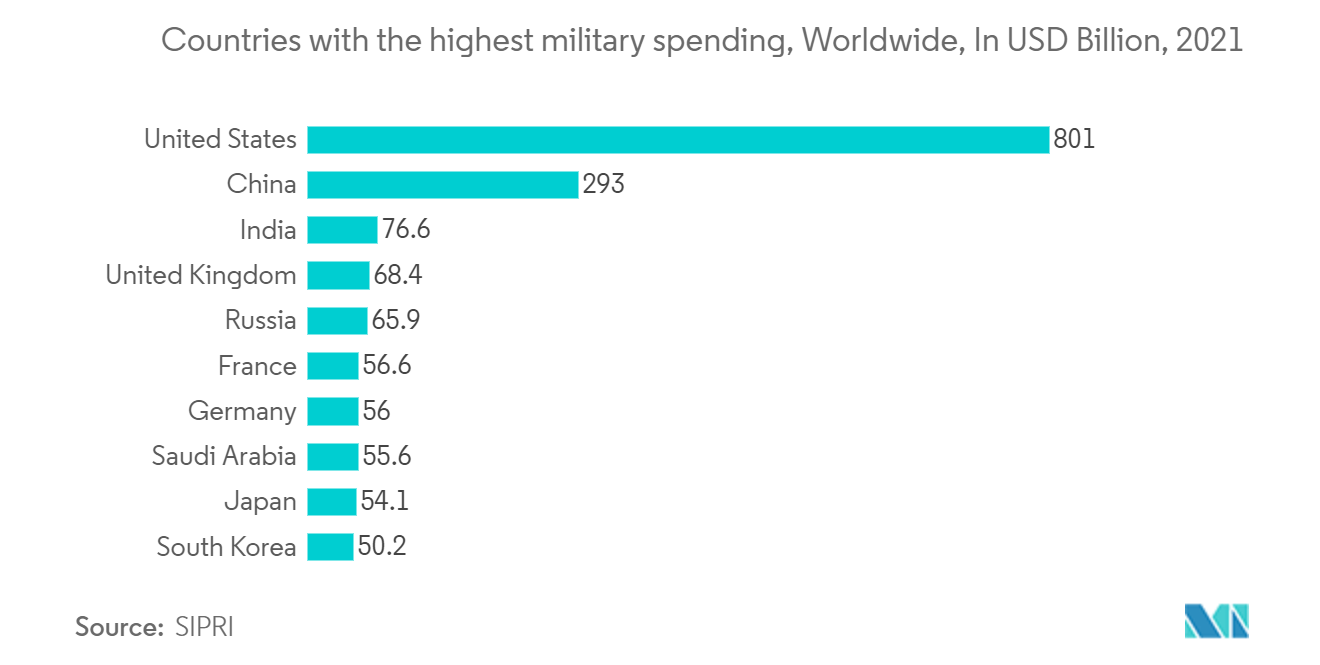
North America to Hold Maximum Market Share
- North America held the largest market share due to several established manufacturers in the region investing significantly in developing and improving existing temperature sensors.
- According to the American Automotive Policy Council, Automakers and their suppliers are America's largest manufacturing sector, responsible for 3% of America's GDP. Moreover, over the past five years alone, FCA US, Ford, and General Motors have announced nearly USD 35 billion in investments in their U.S. assembly, engine and transmission plants, R & D labs, headquarters, administrative offices, and other infrastructure that connects and supports them.
- Companies in the region, such as Emerson Electric Co., offer thermocouple temperature sensors that feature resilience and durability in harsh process environments. Other companies, such as Vernier Software and Technology, offer thermocouple temperature sensors to measure temperatures between -200oC to 1400oC. It can also measure flame temperatures as high as 1400 ̊C or liquid nitrogen temperatures at -196 ̊C.
- Moreover, the region is expected to supply much of the world's growing demand for oil over the next five years, according to the International Energy Agency (IEA). As per the IEA, the United States is expected to account for 80% of the global oil supply increase between 2017 and 2025 as shale producers find more ways to pump oil profitably at lower prices. Thus, the country's growing oil and gas sector is likely to boost further the demand for the market studied over the forecast period.
- With the U.S. Department of the Interior planning to allow offshore exploratory drilling in about 90% of the Outer Continental Shelf (OCS) acreage under the National Outer Continental Shelf Oil and Gas Leasing Program (National OCS Program) for 2019-2024, the oil and gas sector in the region is expected to open up new opportunities to the market.
- Additionally, the healthcare industry uses temperature sensors extensively for continuous cardiac output monitoring, thermal dilution catheters, etc. With such advancements across various industries in the region and the R & D of various types of temperature sensors being integrated into more and more products, the market for temperature sensors is set to grow at a healthy rate.
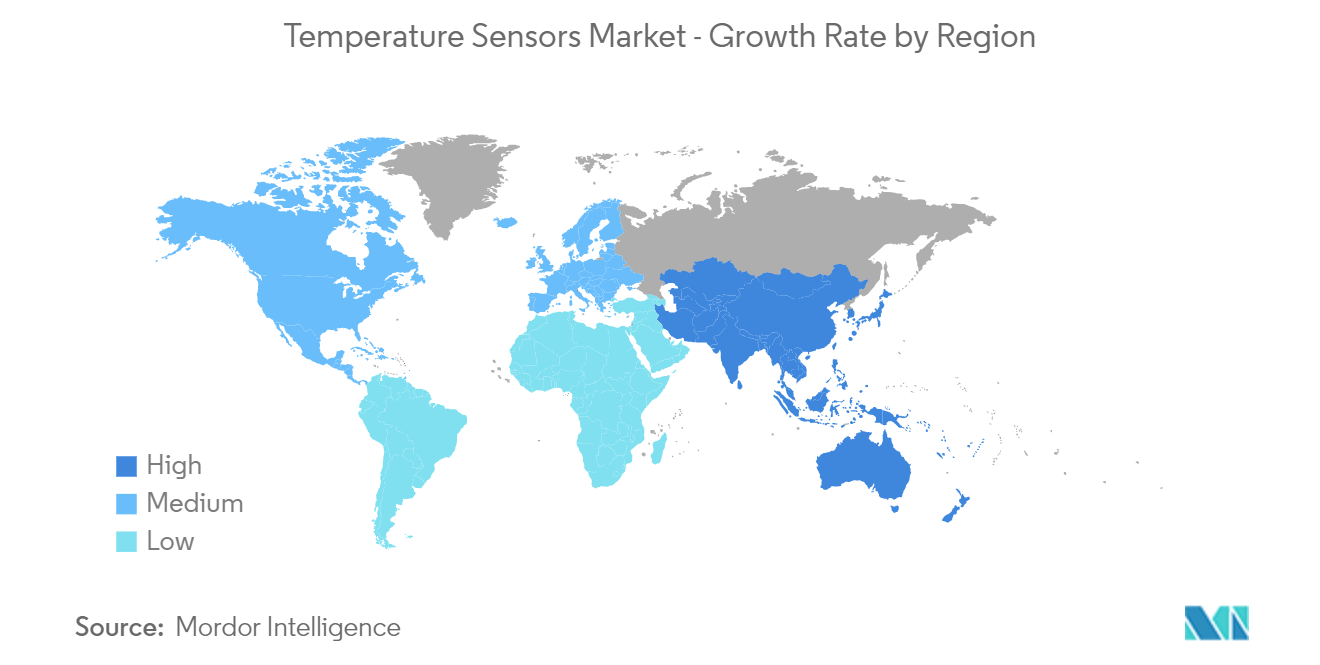
Temperature Sensors Industry Overview
The competitive rivalry is high in this market, owing to the presence of many players operating in the market, such as Honeywell, Texas Instruments, and STMicroelectronics, among other regional and local manufacturers. Continuous product upgradation and industry convergence drive the market towards highly differentiated offerings.
In December 2022, OMEGA Engineering announced the launch of the latest version of its HANI Clamp-On Temperature Sensor: the HANI Clamp Sensor is explicitly designed for plastic pipe applications. The Sensor precisely measures the temperature of media inside a pipe in seconds without ever breaching the pipe.
In July 2022, Apple introduced temperature sensors in its Apple Watch. The company aims to inform the wearer if they have a fever due to a higher-than-normal body temperature.
Temperature Sensors Market Leaders
Honeywell International Inc.
Siemens AG
ABB Ltd.
Texas Instruments Inc
Emerson Electric Co.
*Disclaimer: Major Players sorted in no particular order
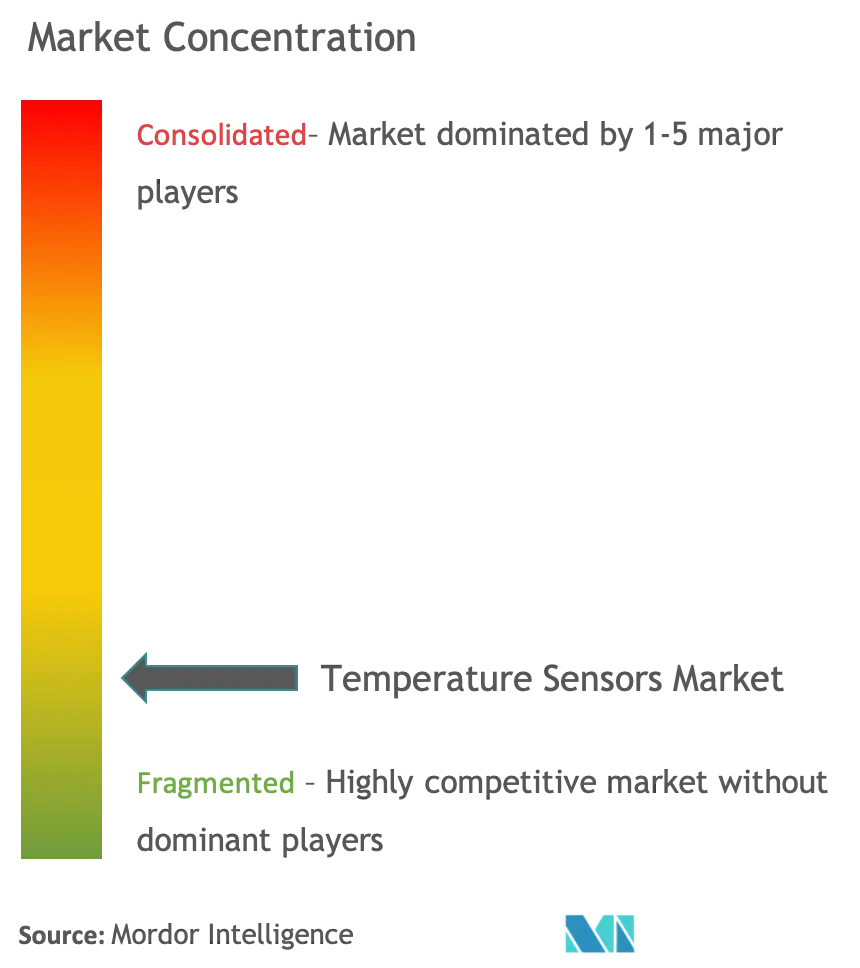
Temperature Sensors Market News
- June 2022: Renesas Electronics announced a new family of relative humidity, temperature sensors, and related solutions. The sensors provide high accuracy, fast measurement response time, and ultra-low power consumption in a small package size to support deployment in portable devices or products designed for harsh environments.
- March 2022: Honor launched Earbuds 3 Pro with integrated temperature monitoring technology. Honor's buds would include a temperature sensor combined with an AI temperature algorithm that can measure with approximately 80% chance of achieving approximately ±0.3 degrees Celcius or less error.
Temperature Sensors Market Report - Table of Contents
1. INTRODUCTION
1.1 Study Assumptions and Market Definition
1.2 Scope of the Study
2. RESEARCH METHODOLOGY
3. EXECUTIVE SUMMARY
4. MARKET DYNAMICS
4.1 Market Overview
4.2 Industry Attractiveness - Porter Five Forces
4.2.1 Bargaining Power of Suppliers
4.2.2 Bargaining Power of Buyers
4.2.3 Threat of New Entrants
4.2.4 Intensity of Competitive Rivalry
4.2.5 Threat of Substitute Products
4.3 Industry Value Chain Analysis
4.4 Assessment of the Impact of COVID-19 on the Market
5. MARKET DYNAMICS
5.1 Market Drivers
5.1.1 Growth in Industry 4.0 & Rapid Factory Automation
5.1.2 Increasing Demand for Wearable in Consumer Electronics
5.2 Market Restraints
5.2.1 Fluctuation in Raw Material Prices
6. MARKET SEGMENTATION
6.1 Type
6.1.1 Wired
6.1.2 Wireless
6.2 Technology
6.2.1 Infrared
6.2.2 Thermocouple
6.2.3 Resistance Temperature Detectors (RTD)
6.2.4 Thermistor
6.2.5 Temperature Transmitters
6.2.6 Fiber Optic
6.2.7 Others
6.3 End-User Industry
6.3.1 Chemical and Petrochemical
6.3.2 Oil and Gas
6.3.3 Metal and Mining
6.3.4 Power Generation
6.3.5 Food and Beverage
6.3.6 Automotive
6.3.7 Medical
6.3.8 Aerospace and Military
6.3.9 Consumer Electronics
6.3.10 Other End-User Industries
6.4 Geography
6.4.1 North America
6.4.1.1 United States
6.4.1.2 Canada
6.4.2 Europe
6.4.2.1 United Kingdom
6.4.2.2 Germany
6.4.2.3 France
6.4.2.4 Rest of Europe
6.4.3 Asia Pacific
6.4.3.1 China
6.4.3.2 India
6.4.3.3 Japan
6.4.3.4 South Korea
6.4.3.5 Rest of Asia Pacific
6.4.4 Latin America
6.4.4.1 Brazil
6.4.4.2 Mexico
6.4.4.3 Rest of Latin America
6.4.5 Middle East and Africa
6.4.5.1 United Arab Emirates
6.4.5.2 Saudi Arabia
6.4.5.3 Rest of Middle East and Africa
7. COMPETITIVE LANDSCAPE
7.1 Company Profiles
7.1.1 Siemens AG
7.1.2 Panasonic Corporation
7.1.3 Texas Instruments Incorporated
7.1.4 Honeywell International Inc.
7.1.5 ABB Ltd
7.1.6 Analog Devices Inc.
7.1.7 Fluke Process Instruments
7.1.8 Emerson Electric Company
7.1.9 STMicroelectronics
7.1.10 Microchip Technology Incorporated
7.1.11 NXP Semiconductors NV
7.1.12 GE Sensing & Inspection Technologies GmbH
7.1.13 Robert Bosch GmbH
7.1.14 Günther GmbH Temperaturmesstechnik
7.1.15 TE Connectivity Ltd
7.1.16 Denso Corporation
7.1.17 Omron Corporation
7.1.18 FLIR Systems
7.1.19 Thermometris
7.1.20 Maxim Integrated Products
7.1.21 Kongsberg Gruppen
- *List Not Exhaustive
8. INVESTMENT ANALYSIS
9. FUTURE OUTLOOK
Temperature Sensors Industry Segmentation
Temperature sensors are devices used to measure temperature readings via electrical signals. The sensor is made of two metals that generate electrical voltage or resistance once it notices a temperature change. The temperature sensors have various sensor types based on the technology type, such as Infrared, Thermocouple, Resistance Temperature Detectors (RTD), thermistors, and others. The report describes the type of sensors, such as wired and wireless, and also provides the study of output, which are analog and digital. The end-user industry comprises temperature sensor applications and majorly includes Chemical and Petrochemical, Oil and Gas, Metal and Mining, Power Generation, Food and Beverage, Automotive, Medical, Aerospace & Military, and others.
The Temperature Sensors market is segmented by Type (Wired, Wireless), Technology (Infrared, Thermocouple, Resistance Temperature Detectors, Thermistor, Temperature Transmitters, Integrated Circuit, Fiber optics), End-user Industry (Chemical and Petrochemical, Oil and Gas, Metal and Mining, Power Generation, Food and Beverage, Automotive, Medical, Consumer Electronics, Aerospace, and Military), and Geography (North America, Europe, Asia-Pacific, Latin America, MEA). The market sizes and forecasts are provided in terms of value (USD million) for all the above segments.
| Type | |
| Wired | |
| Wireless |
| Technology | |
| Infrared | |
| Thermocouple | |
| Resistance Temperature Detectors (RTD) | |
| Thermistor | |
| Temperature Transmitters | |
| Fiber Optic | |
| Others |
| End-User Industry | |
| Chemical and Petrochemical | |
| Oil and Gas | |
| Metal and Mining | |
| Power Generation | |
| Food and Beverage | |
| Automotive | |
| Medical | |
| Aerospace and Military | |
| Consumer Electronics | |
| Other End-User Industries |
| Geography | |||||||
| |||||||
| |||||||
| |||||||
| |||||||
|
Temperature Sensors Market Research FAQs
How big is the Temperature Sensors Market?
The Temperature Sensors Market size is expected to reach USD 8.80 billion in 2024 and grow at a CAGR of 6.28% to reach USD 11.94 billion by 2029.
What is the current Temperature Sensors Market size?
In 2024, the Temperature Sensors Market size is expected to reach USD 8.80 billion.
Who are the key players in Temperature Sensors Market?
Honeywell International Inc., Siemens AG, ABB Ltd., Texas Instruments Inc and Emerson Electric Co. are the major companies operating in the Temperature Sensors Market.
Which is the fastest growing region in Temperature Sensors Market?
Asia Pacific is estimated to grow at the highest CAGR over the forecast period (2024-2029).
Which region has the biggest share in Temperature Sensors Market?
In 2024, the North America accounts for the largest market share in Temperature Sensors Market.
What years does this Temperature Sensors Market cover, and what was the market size in 2023?
In 2023, the Temperature Sensors Market size was estimated at USD 8.28 billion. The report covers the Temperature Sensors Market historical market size for years: 2019, 2020, 2021, 2022 and 2023. The report also forecasts the Temperature Sensors Market size for years: 2024, 2025, 2026, 2027, 2028 and 2029.
Temperature Sensor Industry Report
Statistics for the 2024 Temperature Sensor market share, size and revenue growth rate, created by Mordor Intelligence™ Industry Reports. Temperature Sensor analysis includes a market forecast outlook to 2029 and historical overview. Get a sample of this industry analysis as a free report PDF download.
